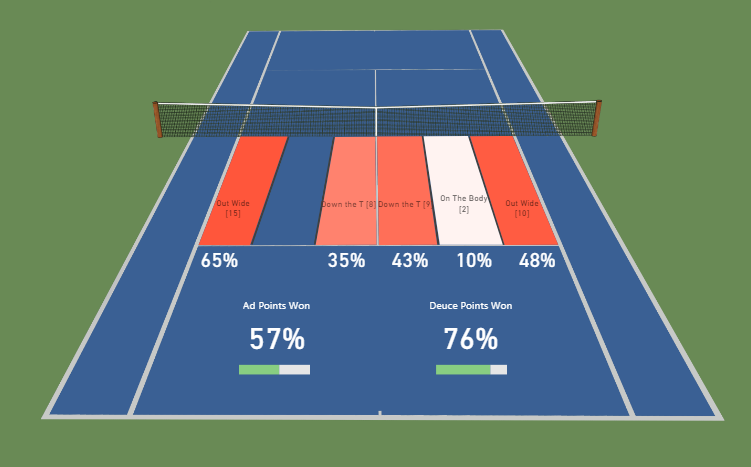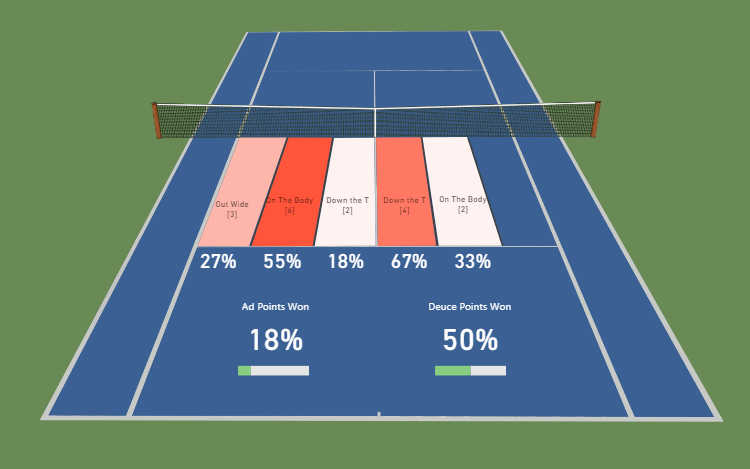Carlos Alcaraz lost 7-6,6-1. This is a scoreline that has seldom been seen in the recent past. But befittingly, the player on the other side of the net was Jannik Sinner. With this win the Sinner-Alcaraz head-to-head is 4-4.
Sinner stands out as one of the few players on the tour who doesn’t shy away from attacking Alcaraz’s weaponry, particularly his Forehand, and has the ability to match his firepower to outmaneuver him. Here are the key statistical factors that contributed to the Italian’s victory.
First Serves:
Jannik Sinner put forward a well structured pattern of first serves. It was important for Sinner to maintain a good win rate on the First Serves.
Sinner mixed up his first serves T and Wide in the Deuce Court to keep Alcaraz guessing.
In the Ad Court, the serve directed Out Wide to Alcaraz’s Backhand yielded Sinner an impressive win rate of 75%. He followed-up these Wide serves with his powerful Forehand Serve Plus One to get Alcaraz on the move.

Heatmap of Sinner First Serves. Mix up in the Deuce Court with Backhand serves in the Ad Court
Sinner used the Serve out wide to expose the Alcaraz Forehand effectively drawing out Errors.
Second Serves:
Alcaraz won an overall of 48% First Serve points. But the stat of interest is that he won a measly 29% Second Serve Points!

Alcaraz Second Serve Heatmap. He won only 18% of points in the Ad Court.
Sinner dominated Second Serve Returns in the Ad Court with a win rate of over 82%. He achieved this by directing his Returns deep into the Alcaraz Backhand time and again.
Sinner returned Second Serves to the Alcaraz Backhand consistently,
instantly neutralizing the control of the rally
| Alcaraz S+1 Forehand | Alcaraz S+1 Backhand | |
|---|---|---|
| First Serve | 62% | 38% |
| Second Serve | 21% | 79% |
As seen in the table, Sinner denied Alcaraz from hitting a Forehand behind the Second Serve throughout the match.
Due to this, Alcaraz was never truly was able to put too much weight behind his Second Serve. It is a rarity to see him hit so many Backhand Serve Plus One’s.
When we look at the stroke utilization throughout the match, Alcaraz hit 52% Backhands from the baseline and 48% Forehands. This just goes to show that Sinner was successful at preventing Alcaraz from using his Forehand and at the same time used his own Forehand very effectively. Sinner splendidly pinned the Backhand time and again to use his own Forehand Cross Court waiting for the opportune moment.
Rally Lengths:
Analysing Rally Lengths and the respective win rates gives a very interesting perspective of the match. A majority of points in tennis lie in the 0-4 rally length zone. Fewer in the 5-8 zone and the least in the 9+ zone.
| 0-4 Points Won | 5-8 Points Won | 9+ Points Won | |
|---|---|---|---|
| Carlos Alcaraz | 47% | 40% | 57% |
| Jannik Sinner | 53% | 60% | 43% |
Sinner held a narrow lead in the short points winning 53% points. The main point of interest is the 5-8 shot rallies. Sinner ended up winning 60% of them.
Sinner was able to win the points where he was able to get Alcaraz involved in Backhand rallies. At times completely overpowering Alcaraz.
Alcaraz won more in the 9+ points winning 57% points. This did not make too much of an impact on the match since the total number of points lasting more than 9 shots was only 14, out of which he won 8.
Conclusion:
Sinner executed a well planned strategy to take the win in Beijing. Most importantly, he stuck to the same throughout the match. Even through the early breaks in the first set, he looked completely unperturbed and stuck to the strategy. It is hardly an easy feat to defeat Alcaraz in straight sets.
The Spanish player and his coach will surely head back to the drawing board to make the appropriate strategy changes.
It will be interesting to observe what Alcaraz changes in the upcoming matchups to counter the Italian.
